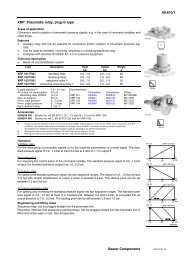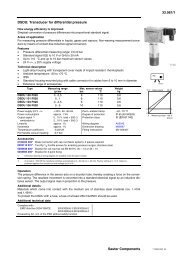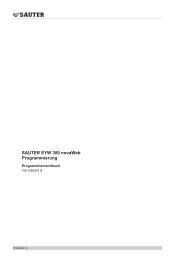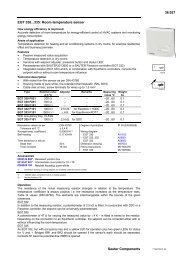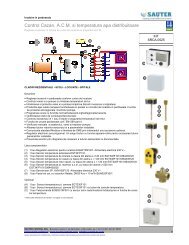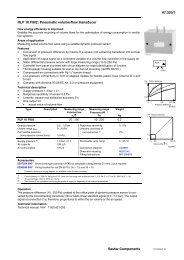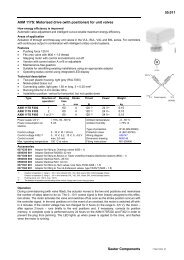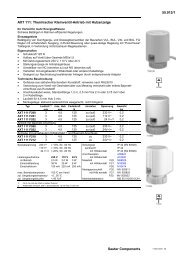nova220, Compact automation station with BACnet interface
nova220, Compact automation station with BACnet interface
nova220, Compact automation station with BACnet interface
Create successful ePaper yourself
Turn your PDF publications into a flip-book with our unique Google optimized e-Paper software.
SAUTER EY3600PDS 92.450 en Product Data Sheet EYK220EYK220: <strong>nova220</strong>, <strong>Compact</strong> <strong>automation</strong> <strong>station</strong> <strong>with</strong> <strong>BACnet</strong> <strong>interface</strong>This EYK220 is the compact <strong>nova220</strong> units of the EY3600 system family equipped <strong>with</strong> a <strong>BACnet</strong>communication card (EYK300). This communication card is used to integrate Sauter's <strong>nova220</strong> <strong>automation</strong><strong>station</strong> <strong>with</strong> the standardised communication protocol ‘<strong>BACnet</strong>/IP based on Ethernet’ as per EN 13321-1 andISO 16484-5. This <strong>nova220</strong> has communication capability <strong>with</strong> novaNet and Ethernet and can be networked<strong>with</strong>out any further provisions having to be made. The unit is programmed (parameterised) using a PC <strong>with</strong> theEY3600 CASE software and the CASE FBD Editor as per IEC 1131-3.The <strong>station</strong> has all assemblies and <strong>interface</strong>s necessary for operation, for the connection of plant devices and forcommunication <strong>with</strong> other <strong>station</strong>s and <strong>with</strong> the management level. As a <strong>BACnet</strong> server, it provides all the objectsrequired for HVAC applications, plus the associated properties <strong>with</strong> the necessary services. Typical users(<strong>BACnet</strong> clients) of this information are open management systems, bus-wide operating units, and other <strong>automation</strong><strong>station</strong>s which have <strong>BACnet</strong> capability etc.. In its function as a <strong>BACnet</strong> client, the communication cardsupports peer-to-peer transmission <strong>with</strong> ‘present-value properties’ for the specified objects.ProductsType Description Weight (kg)EYK220F001 <strong>Compact</strong> AS <strong>with</strong> <strong>BACnet</strong> <strong>interface</strong> 3.2Technical dataElectrical supplyInterfaces, communication (continued)Power supply 230 V~, 50/60 Hz COM <strong>interface</strong> DB9 plug as per DTEPower consumption 28 VA <strong>BACnet</strong> <strong>interface</strong> RJ45-EthernetPower loss, max. approx. 31 W Transport protocol <strong>BACnet</strong>/IPExecutionPermitted ambient conditionsFactory setting All switches set to "Off" Operating temperature 0…45 °C (32…113 °F)Number of <strong>BACnet</strong> objects max. 1000 (Total) Storage and transport temperature –25…70 °C (–13….158 °F)Number of time programs max 100 (Schedule) Humidity 10…90% rh no condensationNumber of calendarsmax. 40 (Calender)Number of historicalInstallationdata objects max. 50 (Trend Log) Dimensions W × H × D 280 × 266 × 78 mmlog data records (Total) max. 10'000 (Log Buffer) 11" × 10.5 " × 3" inchWeight (kg) 3.2Inputs/OutputsDigital inputs 32 Standards, guidelines and directivesDigital outputs 4× 0-I Degree of protection IP 00 (EN 60529)4× 0-I-II Protection class I (IEC 60730)Analogue inputs 8× Ni/Pt1000 Environmental class 3K3 (IEC 60721)6× U/I/R CE conformity as perAnalogue outputs 6× 0…10 V Directive 2006/95/EC EN 60730(2× 0…20 mA) EMC Directive 2004/108/EC EN 61000-6-1Counters 2 EN 61000-6-2EN 61000-6-3 1)Interfaces, communication EN 61000-6-4AS network/novaNet 2× a/b- terminals EN 550241× RJ11 socket (6/6)Local Operating Panel EY-OP240 1× RJ45 socket Additional informationmodu240 languages: Fitting instructions MV 505788German, French, English, Italian, Dutch, Spanish, Swedish, Norwegian, Wiring diagramsA09735Danish, Portuguese, Finnish (for other languages, see 'Accessories')Plug-in-cardA09734Dimension drawingM047441) This is Class A equipment. It may cause radio interference in the home, in which case the operator may be requested to carry out appropriate measures. (see Fitting instructions)AccessoriesTypeEY-OP240DescriptionLocal Operating Panel modu2400501112002 <strong>nova220</strong> microprograms <strong>with</strong> modu240 languages: German, French, English, Polish, Slovenian, Hungarian, Romanian,Russian, Czech, Turkish0367842002 Connecting cable, nova AS – modu240, 1.5 m (4.9 ft)0367842003 Connecting cable, nova AS – modu240, 2.9 m (9.5 ft)0367842004 Connecting cable, nova AS – modu240, 6.0 m (19.7 ft)0367862001 novaNet connecting cable, novaNet290 or novaNet291 – AS, 1.5 m (4.9 ft)www.sauter-controls.com 1/8
EYK220Accessories (continued)TypeDescription0367862002 novaNet connecting cable, novaNet290 or novaNet291 – AS, 2.9 m (9.5 ft)0367862003 novaNet connecting cable, novaNet290 or novaNet291 – AS, 6.0 m (19.7 ft)0367862004 Connecting cable, novaNet RJ11-RJ11, 0.21 m (supplied)0367883002 5× EPROMs (empty) (USER-EPROM)0367888001 5× EPROMS (4 Mbit; empty)0386301001 Connecting cable, COM DB9-DB9, 3 mEngineering notes The <strong>nova220</strong> <strong>automation</strong> <strong>station</strong> can be fitted in a panel using atop-hat rail (EN50022). The card is licensed <strong>with</strong> BACstac and bears a licence sticker.The second licence sticker supplied can be kept in the projectfile or in the subsidiary company or NSO for archiving purposesand as a back-up licence. The EYK220F001 <strong>station</strong> is powered <strong>with</strong> 230 V~. The earthing terminals are connected to ground (PE) and to thehousing. The connection from the <strong>BACnet</strong> communication card to the<strong>automation</strong> <strong>station</strong> is integrated via novaNet. The supplied cable(367862 004) should be connected to the RJ11 socket. The Ethernet link is made via an RJ45 socket. Communication iseffected via the <strong>BACnet</strong>/IP transport protocol. The configuration of this IP address and other parameters iseffected via the Sauter software module ‘<strong>BACnet</strong> Server Configurator’.See <strong>BACnet</strong> manual 7001007 003. The <strong>BACnet</strong> communication card implements the ‘<strong>BACnet</strong>Server/Client functionality’ in Sauter DDC type <strong>nova220</strong>. The MFAs (machine fine addresses) used in the <strong>automation</strong><strong>station</strong> are converted – when the house address (data points)has been projected – into ‘<strong>BACnet</strong> objects’, whereby the managementand updating of the relevant <strong>BACnet</strong> object list aredone automatically. This means that there is no additional generatingneeded in order to integrate the <strong>BACnet</strong> functionality atDDC level. Using the similarly implemented Scheduler (day and week calendar)and the associated ‘Schedule and Calendar <strong>BACnet</strong> objects’,it is possible to process local <strong>BACnet</strong> time programs andalso, therefore, to control process variables of the connected ASin accordance <strong>with</strong> a time programme. The DDC data points can be transmitted either by <strong>BACnet</strong> clientsvia cyclical polling or by the COV (Change Of Valve) subscriptionmechanism on the <strong>BACnet</strong> communication card. Others <strong>BACnet</strong> specifications, as per separate <strong>BACnet</strong> PICS(Protocole Implementation Statement) specification. See document„Sauter-<strong>BACnet</strong>-PICS.pdf“ The plant devices are connected via spring-type terminals. Thefollowing conditions must be observed:Connection requirements for devicesCable size min. 0.8 mm² (AWG 18), max. 2.5 mm²(AWG 13), adhering to the normsnovaNet <strong>with</strong> twisted cableDigital inputs potential-free contacts opto-coupler transistors (open collector)Digital outputs < 250 V~/2 (2)A to the relay contactsAnalog inputs < 10 V=Analog outputs no extraneous voltageCounters potential-free contacts opto-coupler transistor (open collector)Description of inputs and outputsTemperature measurementNumber of inputs 8Type of inputs Ni1000 (<strong>with</strong>out coding) Pt1000 (software coding)Measuring Ni1000: –50...+150 °C (–58...+302°F)ranges: Pt1000: –100...+500 °C (–148...+932°F)Linear-correction (Y = a X + b)factors a and bSlope aNo entry is needed here. A proportionalfactor, which gives the result in °C, can becalled up direct from the microprogram.Zero-point shift b No calibration is needed here. A line resistanceof 2 is included and has been compensatedfor. If the line resistance R isgreater (deviation 2 ): b = –0.18 × (R – 2 ) in room-temperaturerange or b = –0.16 × (R – 2 ) at approx. 100°CThe eight inputs, which do not need calibrating, already take theresistance of the cable into account and can be used for Ni1000and Pt1000. The sensors are connected using two-wire technology;the connecting leads can be up to 55 m (180 ft) long if0.8 mm² (AWG 18) or 170 m (558 ft) if 1.5 mm² (AWG 15). Themeasuring voltage is pulsed in order to prevent the sensor fromwarming up.The inputs are intended for Ni1000 sensors. Due to the linearisation,a deviation of only 0.06 °C is attained. Pt1000 sensors canalso be used.The type of measurement can be chosen via the software.The linearisation for Pt1000 guarantees negligible error between–50 and +100 °C (–58...212°F).2/8 www.sauter-controls.com
EYK220For the full measuring range of the Pt1000, see the following table:Measuring accuracyTemperatureAbsolute difference–100 °C (–148°F) –0.05 °C (–0.09°F)–50 °C bis +100 °C (–58...212°F) < ± 0.02 °C (± 0.04°F)+150 °C (302°F) +0.05 °C (+0.09°F)200 °C(392°F) +0.11 °C (+0.2°F)300 °C (572°F) +0.29 °C (+0.52°F)400 °C (752°F) +0.10 °C (+0.18°F)500 °C (932°F) –0.31 °C (–0.56°F)U/I/R measurementNumber of inputs 6Type of inputs 3 U/I/R3 U/IVoltage0 (2)...10 V0 (0.2)..1 VCurrent0 (4)...20 mAPotentiometer 0 to 500 ...2 kLinearcorrection (Y = a X + b)factors a and b The linearity can be adapted very accuratelyfor every input.Settings for a standardised signal (0...1)Linear-correction factorsa b Inputs1 0 0...10 V10 0 0...1 V1 0 0...20 mA20 0 0...1 mA1.25 –0.25 2...10 V1.25 –0.25 4...20 mA12.5 –0.25 0.2...1 VInput limit valuesMeasurement of voltage < ± 50 VMeasurement of current < 50 mALoading of reference outputs < 10 mAReturn line for all signals earthAccuracy U = ± 0.1% (± 0.01 V)I = ± 0.1% (± 0.02 mA)R = ± 0.5% (± 0.05 V)ResolutionU = 5 mVMeasuring the voltage (U)Voltage can be measured at all 6 inputs. The voltage is measuredbetween one of the input terminals for voltage (marked <strong>with</strong> a 'U')and an earth terminal. The signal must be potential-free. The twomeasurements 0 (0.2)...1 V and 0 (2)...10 V are selected via thesoftware.The maximum voltage <strong>with</strong>out damage being incurred is < ± 50 V.The visible range, however, is limited to 10 V. The internal resistanceRi of the input (load) is 60 k in this case.Measuring the current (I)Current can also be measured at all 6 inputs. There are specialterminals (marked <strong>with</strong> an 'I') available for measuring the current.The current signal must also be potential-free. The maximum inputcurrent must be limited to 50 mA. The internal resistance Ri is100 .Measuring the resistance (R)The potentiometer is connected to terminals U, earth and +1 V; theuse of all six measurement inputs requires that the referenceoutputs are doubly occupied. The +1 V reference voltage is pulsed.In order not to overload the reference outputs, the lowest potentiometervalue should not be less than 500, even if parallel circuitedin the case of double occupation. The reference output isprotected against short circuits. The potentiometer’s upper value of2 k is prescribed in order to guarantee stable measurements freeof interference.Pulse meteringNumber of inputs 2Type of inputs potential-free contacts opto-coupler transistor (open collector)Input frequency< 15 HzMax. output current of the 0.7 mA <strong>with</strong> respect to earthinputsDe-bounce time20 msProtected against extraneous up to 24 V ac/dcvoltagePotential-free contacts, opto-couplers or transistors <strong>with</strong> opencollectors can be connected to the meter inputs. The maximumpulse frequency is 15 Hz. A de-bounce time of 20 ms is envisagedso that the switching contacts are correctly received. The pulse isreceived on the falling flank and can remain present indefinitely.The <strong>automation</strong> <strong>station</strong>'s internal counter value is interrogatedevery cycle and stored in DW 2 as a dual partial sum. The summationto form the actual counter value is done by the software after30s at the latest via the <strong>station</strong>'s processor in DW 6. Through usingthe FP format, the counter value can have a maximum of approx.2.147 × 10 9 .With the FP format, it is possible to show counter values up to67,108,864 <strong>with</strong> a resolution of 1. Any counter overflow can becurbed by resetting using the 'C_Preset' function module.Digital inputsNumber of inputs 32Type of inputs potential-free contacts, <strong>with</strong> respectto earth opto-coupler transistor (open collector)Max. output current of 0.7 mA <strong>with</strong> respect to earththe inputDe-bounce time 20 msProtected against up to 24 V a.c./d.c.extraneous voltageThe <strong>nova220</strong> <strong>station</strong> processes 32 items of digital information. Themonitored inputs are connected between the input terminals andearth. The <strong>station</strong> applies a voltage of approx. 24 V to the terminal.When the contacts are open, this corresponds to bit = 0. When thecontacts are closed (equivalent to bit = 1), a current of approx.1 mA flows at 0 V. Brief changes of 30 ms (at the shortest) betweenthe <strong>station</strong>'s queries are first placed in the buffer and thenprocessed at the next cycle.It is possible to decide separately for each input whether it shouldbe defined as an alarm or a status input.Digital outputsNumber of outputs 4× 0-I4× 0-I-IIType of outputs relaysOutputs' loading 250 V~/2 (2)AThe digital outputs can also be used as 8× 0-I. The feedbacksignals can be received (exclusively genuine) via the digital inputs.www.sauter-controls.com 3/8
EYK220Analogue outputsNumber of outputs 6Type of outputs 4× 0(2)...10 V d.c., 20 mA max.2× 0(2)...10 V or 0...20 mAnovaNet addressingThe output voltage is tapped between the relevant output terminaland an earth terminal. Two outputs can provide 0...20 mA. Theoutputs are protected against static discharges, but not againstlocal alternating or direct current, which can destroy the protectivediode and the output driver. For this reason, the plant device (e.g.a valve drive) should always be connected in the plant first. Then acheck should be made at the <strong>station</strong> to ensure that there is nopotential at all (i.e. 0 V) at both wires <strong>with</strong> respect to earth and <strong>with</strong>respect to each other. If this is the case, the earth lead should beconnected first and the signal lead last to their respective terminalsin the <strong>station</strong>.The <strong>nova220</strong> <strong>automation</strong> <strong>station</strong> has a fast operating programwhich reads in all inputs, processes the parameterised modules,updates the outputs and carries out the necessary communication<strong>with</strong> other <strong>station</strong>s or <strong>with</strong> visualisation PCs.A real-time clock for the time programmes is also integrated in the<strong>automation</strong> <strong>station</strong>s. A lithium battery ensures that the user data(FBD data), time programmes and historical data (HDB) are retainedin the SRAM in the event of a power failure. The real-timeclock also runs off this lithium battery.The battery makes it possible to retain the data and run the realtimeclock for at least 10 years <strong>with</strong>out power applied. Date andtime are set ex works. When power is restored, the <strong>automation</strong><strong>station</strong> checks the consistency of the data and starts communication.The user programmes can be loaded from any point in thenovaNet. The data stay in the battery-backed SRAM even in theevent of a power failure. In addition, the data can be stored captivein a user EPROM. Therefore, the level of protection against loss ofdata is very high.Every <strong>station</strong> needs an AS address (0...28671), which is set viacoding switches.The <strong>station</strong> is programmed (control loops and parameters) via thenovaNet <strong>automation</strong> network. The data are then stored in a battery-backedmemory. The battery's serviceable life is at least tenyears. The data can be saved permanently by means of theUSER-EPROM.Every <strong>station</strong> needs an AS address, which is set via codingswitches.Putting into operationWhen connecting the power supply, the earthing lead must beconnected to the screw terminal provided (protection class I).When working on the units, the power supply must be disconnected.Before being linked to the novaNet, each <strong>station</strong> must begiven a clear (unique) address. This <strong>station</strong> number is binaryencodedvia the block of DIP switches and can be between 1 and4194 (for the <strong>BACnet</strong> <strong>station</strong>s).The AS address is set by means of the 16-digit switch-blocks. Thelast switch is for setting the parity, which refers to the address andnot to the four other switches situated below. The parity should beset so that the number of switches in the 'on' position, includingparity, is even.Example: 2048 + 8 + 4 + 2 + 1 = 2063The following example is intended as an explanation of the binaryencoding: Station number 2063This AS number fort he EYK220F001 has to be set between 1 and4194If the <strong>station</strong> has not already got an EPROM <strong>with</strong> the parameteriseduser data, they must be transmitted to the <strong>station</strong>.Communication is always performed via the novaNet EY3600 busand the corresponding terminals or the RJ-11 connector. Programmingcan be done in parallel to the data traffic, though thismay lengthen the response time of the other network subscribers.For this reason, the <strong>station</strong> can be separated from the novaNet forthe duration of the data transfer and the 'parameterising' PC canbe connected locally. After the data transfer has been complete,the data are immediately active. The <strong>station</strong> can then be reconnectedto the network and is ready for operation.You are strongly advised to copy the user data in an EPROM,which can be loaded <strong>with</strong> any normal programming device and putinto the <strong>station</strong>.This greatly increases security and simplifies fault-finding.Before being opened, the <strong>station</strong> must be removed from the powersupply! Protective measures to prevent electrostatic dischargesmust be taken before performing any work on integrated circuits.The <strong>station</strong> must then be reset using the reset switch.4/8 www.sauter-controls.com
EYK220<strong>nova220</strong>UIUIUIQCQC333435363738391011121314DIDIDIDIDIDIDIDIDIDIDI151617181950515253545556DIDIDIDIDIDIDIDIDIDIDI575859606162636465666768DIDIDIDIDIDIDIDIDIDI697071727374757677787980Off On1248163264128256512102420484096819216384EvenResetBCDUser DataMicropr.(1 MBit)(4 MBit)501112.001B05783aResetONResetBCDB04726The reset switch is set to 'ON' for approx. ½ s, causing the <strong>station</strong>to load the user data from the EPROM and to start operation underdefined starting conditions.If the reset switch is left in the ‘ON’ position, the <strong>station</strong> remains inthe reset mode and cannot function correctly. All versions have inthe top left-hand corner three LEDs which indicate the status of the<strong>automation</strong> <strong>station</strong>. The green LED, at the top, indicates that thepower supply is on when lit continuously; the two yellow LEDsindicate telegram traffic in both directions on the novaNet. If the<strong>station</strong> has stopped or a fault has been detected in the RAM, thewatchdog detects this and the <strong>station</strong> is then restarted <strong>with</strong> theEPROM data. In this case, no telegrams are sent to the exterior fora brief period, so the yellow 'Send' LED (at the bottom) no longerflashes. If this LED does not light up, it means that the EPROM iseither the wrong one or is faulty, or that no EPROM has beeninserted. In this case, the <strong>station</strong> is no longer operable. In standalonemode (<strong>with</strong>out novaNet), the 'Receive' LED (in the middle)remains unlit; the 'Send' LED flashes quickly (approx. 7 times persecond), since a dummy telegram is sent each cycle.If the <strong>station</strong> is reset manually, the microprogram and the user dataare also read in afresh. As soon as this has been done, the yellow'Send' LED again flashes in time to the outgoing telegrams.LED display for Ethernet <strong>interface</strong>Status off Application could not be correctly initialisedred <strong>BACnet</strong> device offline; no novaNet connection;memory capacity is near to its limitred Flashing every ¼ second: communication error<strong>BACnet</strong>green Flashing: novaNet communicationSpeed yellow Data transmission speed; is recognised automatically: LED off: 10 Mbits/s LED on: 100 Mbits/sLI yellow Physical link established (Link)ACT yellow Transmission of <strong>BACnet</strong> protocol (Activity)www.sauter-controls.com 5/8
EYK220Relationship between MFAs and terminals<strong>nova220</strong> connectionNi1000/Pt1000Analogue inputU/I/RU/I/RU/I/RU/I/RU/I/RU/I/RAnalogue output0-10 V0-10 V0-10 V0-10 V0-10 V or 0-20 mA0-10 V or 0-20 mADigital output0-I0-I0-I0-I0-I-II0-I-II0-I-II0-I-IIPulse counterDigital inputMFA Bit Code TerminalsGNDInput00 51 5 601 51 7 802 51 9 1003 51 11 1204 51 13 1405 51 15 1606 51 17 1807 51 19 20GND U/R I +1 V Ref.08 50 21 22 23 2409 50 25 26 27 2810 50 29 30 31 3211 50 33 34 3512 60 36 37 3813 60 39 40 41GND U I20 82 122 12321 82 122 12422 82 125 12623 82 125 12724 81 128 129 13025 81 131 132 133COM I II32 20 102 10333 20 104 10534 20 106 10735 20 108 10936 20 110 111 11237 20 113 114 11538 20 116 117 11839 20 119 120 121GNDInput50 C1 42 4351 C1 42 44GNDInput52-1 24 10 4652-2 25 10 45/ 4752-3 26 10 57/ 4852-4 27 10 69/ 4952-5 28 10 80/ 5052-6 29 10 5152-7 30 10 5252-8 31 10 5353-1 24 10 5453-2 25 10 5553-3 26 10 45/ 5653-4 27 10 57/ 5853-5 28 10 69/ 5953-6 29 10 80 6053-7 30 10 6153-8 31 10 6254-1 24 10 6354-2 25 10 6454-3 26 10 45/ 6554-4 27 10 57/ 6654-5 28 10 69/ 6754-6 29 10 80 6854-7 30 10 7054-8 31 10 7155-1 24 10 7255-2 25 10 7355-3 26 10 45/ 7455-4 27 10 57/ 7555-5 28 10 69/ 7655-6 29 10 80 7755-7 30 10 7855-8 31 10 79Earth connection6/8 www.sauter-controls.com
EYK220Dimension drawingFitting to top-hat railTop-hat rail EN50022 - 35 × 7.5(DIN -3F 35 mm)or EN50022 - 35 × 15211 ±1 (8.3")176 ±1 (6.93")B05960aWiring diagram1 DCD (IN)2 RD (IN)3 TD (OUT)4DTR (OUT)5GND6DSR (IN)7RTS (OUT)8CTS (IN)9 RIN (IN)abnovaNetEthernetCAT-5Ferrit(Würth Typ: 7427135)novaNetRJ11EYT240RJ45COM 1DB9In cases where the industry emissions standard (EN 61000-6-3) has to be met, the Ethernet cable (min. CAT-5 cabel) must be looped <strong>with</strong>three windings through a ferrite bead (Fürth Type: 7427135) in the immediate vicinity of the plug. This requirement is only met <strong>with</strong> hardwareIndex C.www.sauter-controls.com 7/8
EYK220Wiring diagram (continued)In cases where the industry standard (EN 61000-6-2) has to be met, the power cables for the digital inputs (DI), the analogue inputs/outputs(AI/AO) and the counter inputs (CI) should be no longer than 30 m.© Fr. Sauter AGIm Surinam 55CH-4016 BasleTel. +41 61 - 695 55 55Fax +41 61 - 695 55 10www.sauter-controls.cominfo@sauter-controls.com8/8 www.sauter-controls.com7192450003 05Printed in Switzerland





